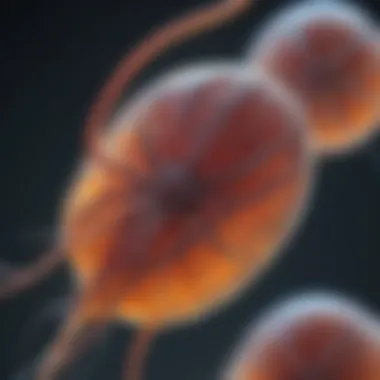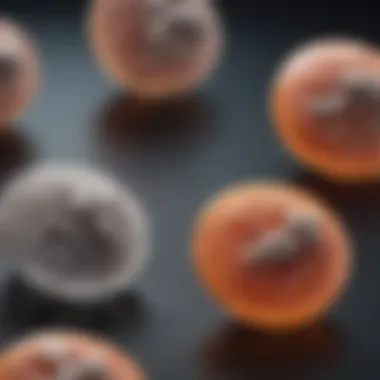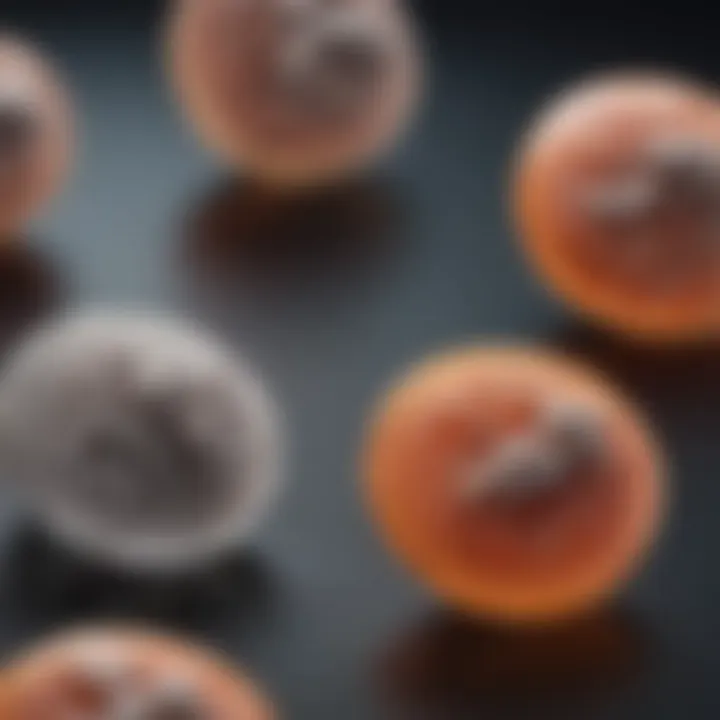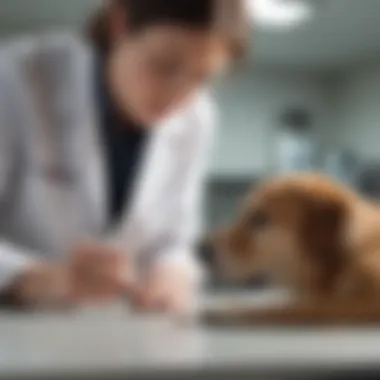Understanding Giardia Transmission Among Dogs


Intro
Giardia is a microscopic parasite that affects many animals and humans. In canines, it can lead to gastrointestinal issues, but understanding its transmission is vital for effective prevention. This section serves as a foundation for dog owners to grasp how Giardia spreads among their pets and the ensuing health implications.
Understanding Your Pet
Breed Traits
Different dog breeds may display varying susceptibility to Giardia infection. For example, breeds with less robust immune systems or those that frequent communal areas are at higher risk. It is crucial to consider these traits when assessing infection risk in your own dog.
Common Temperaments
A dog's temperament can influence its behavior and, indirectly, its exposure to Giardia. Active dogs that socialize frequently may encounter contaminated environments more often. This can be especially true for playful puppies, who are naturally curious and tend to explore with their mouths.
Special Needs
Some dogs may have specific health concerns that contribute to their vulnerability to Giardia. Dogs with compromised immune systems, for example, often require special attention. Identifying these needs early on ensures that proper care and preventive measures are in place.
Pet Care Essentials
Nutrition and Feeding Guidelines
A well-balanced diet is essential for maintaining your dog's immune system. Good nutrition helps in preventing infections like Giardia, which can exploit weakness in a dog's health. Select high-quality dog food containing essential nutrients tailored to your pet's life stage, breed, and health.
Grooming Tips and Techniques
Grooming plays a vital role in preventing the spread of parasites. Regular baths can help remove potential Giardia cysts from your dog's coat, especially after outdoor activities. Always use appropriate shampoos that cater to your pet's skin type to avoid irritations.
Health and Wellness
Routine veterinary check-ups are necessary. These can help to catch infections early on. During these visits, make sure to talk to your vet about the risks of Giardia and ask for advice on preventive treatments. Keeping records of vaccinations and treatments can also provide valuable insight into your dog's health status.
Training and Behavior
Basic Training Techniques
While not directly related to Giardia, basic training can ensure your dog follows commands. This can be beneficial in keeping them away from contaminated areas. For example, a simple command like
Prelude to Giardia
Giardia is a significant parasitic infection that affects many dogs around the world. Understanding its transmission is crucial for pet owners as it directly impacts their dogs’ health and overall well-being. This section aims to provide insight into what Giardia is and its lifecycle, which lays the foundation for comprehending how it spreads among canines.
What is Giardia?
Giardia is a microscopic organism belonging to a group called protozoa. This parasite primarily infects the intestines of dogs, leading to a condition known as giardiasis. It is essential to note that giardiasis is highly contagious and can be transmitted not only between dogs but also between dogs and humans. The infection often manifests with gastrointestinal disturbances, resulting in symptoms such as diarrhea, weight loss, and dehydration. Pet owners should be aware that a dog infected with Giardia can intermittently shed cysts in its feces, which can lead to new infections in other dogs or potentially humans if proper sanitation practices are not followed.
Life Cycle of Giardia
The life cycle of Giardia is complex but can be broken down into two primary stages: the cyst stage and the trophozoite stage.
- Cyst Stage: This is the dormant form of Giardia, present in the environment. When a dog ingests contaminated water, food, or surfaces, cysts enter its digestive system.
- Trophozoite Stage: Inside the intestine, cysts develop into active trophozoites. These organisms attach themselves to the intestinal walls and multiply. Eventually, some trophozoites turn back into cysts that are excreted in feces. This cycle can continue endlessly, leading to widespread infection among dogs and other animals.


Understanding these stages aids in recognizing the risk factors and preventive measures that pet owners can implement. It also emphasizes the importance of keeping environments clean, especially in areas with high dog populations or canine interactions. In the next sections, we will cover how Giardia spreads, along with the potential risks of dog-to-dog transmission.
Transmission of Giardia
Giardia transmission is a critical topic when discussing the health of dogs. Giardia, a microscopic parasite, can disrupt a dog's gastrointestinal function and lead to various health complications. Understanding how Giardia spreads among canines is essential for pet owners and breeders alike. It helps in identifying potential risks and implementing effective preventive measures. Not only does this knowledge contribute to better dog health, but it also fosters a safer environment within communities, particularly in canine-populated areas.
How Does Giardia Spread?
Giardia spreads primarily through the fecal-oral route. When an infected dog passes stool containing cysts, other animals may inadvertently ingest these cysts. This can happen through contaminated water, food, or surfaces. Dogs can also contract Giardia by drinking untreated water from streams or ponds, where the cysts may be present.
The lifecycle of Giardia includes both a cystic form and a trophozoite form. The cysts are hardy and can survive in the environment for extended periods. Because of this resilience, the risk of transmission is significant where multiple dogs congregate. Saliva from an infected dog can also transmit the infection, albeit less frequently. It is vital for pet owners to monitor their dogs' interactions, particularly in dog parks or daycare settings where the risk of exposure heightens.
Dog-to-Dog Transmission Risks
The risks of dog-to-dog transmission are particularly concerning in communal settings. Some factors that enhance these risks include:
- High Population Density: Areas with many dogs, such as shelters and parks, increase the likelihood of contact with fecal material containing cysts.
- Inadequate Hygiene: Poor sanitation practices can lead to a build-up of contaminated material. Routine cleaning and disinfecting of shared spaces is crucial.
- Infection Symptoms: Asymptomatic dogs can still shed Giardia cysts, making it challenging to identify potential carriers.
- Outdoor Activities: Dogs that frequently play outdoors without restrictions can easily come into contact with contaminated surfaces.
Preventive measures are essential. Regular fecal testing helps in early identification of Giardia and can limit the spread of this parasite.
By fostering awareness of these risk factors, dog owners can take appropriate steps to minimize transmission. Their vigilance can greatly contribute to not only their pets' health but also to overall canine welfare in their community.
Signs and Symptoms of Giardia in Dogs
Understanding the signs and symptoms of Giardia in dogs is crucial for early detection and treatment. Giardia, a protozoan parasite, can lead to gastrointestinal issues and negatively impact a dog's overall health. Recognizing these manifestations is essential for dog owners who want to maintain their pets' well-being. Early intervention can mitigate severe health implications and avoid further transmission of the parasite.
Common Clinical Symptoms
Clinicians note that dogs infected with Giardia may exhibit several key symptoms. These symptoms can vary in severity and may appear suddenly or gradually. Common clinical symptoms of Giardia in canines include:
- Diarrhea: Often the most noticeable sign, diarrhea can be acute and watery or chronic and less severe.
- Vomiting: Some dogs may experience vomiting, which can exacerbate dehydration.
- Weight Loss: Gastrointestinal disturbances can lead to weight loss over time.
- Lethargy: Infected dogs often show signs of tiredness and lack of energy.
- Flatulence: An increase in gas production may be noticeable.
Recognizing these signs is important for timely assessment. Regular veterinary check-ups can help spot these symptoms early, potentially leading to quicker treatment options. Sometimes, the symptoms can be mistaken for other gastrointestinal issues, highlighting the need for further evaluation.
Differential Diagnosis
Differential diagnosis is an important aspect of understanding Giardia infections in dogs. It involves differentiating Giardia-related symptoms from those of other intestinal parasites or diseases. Some conditions to consider include:
- Parvovirus: A highly contagious virus that causes severe gastrointestinal symptoms.
- Coccidia: Another protozoan that can cause similar symptoms.
- Bacterial Infections: Such as bacterial gastroenteritis, which can also present with diarrhea and vomiting.
- Food Allergies or Intolerance: May mimic Giardia symptoms but can be treated differently.
Veterinarians often conduct thorough evaluations, including fecal tests, to differentiate between these conditions. Consistent and careful observation of your dog with a focus on their dietary intake, behavior changes, and overall health can provide valuable information during a veterinary consultation. Diagnosis can guide effective treatment plans and prevention strategies, solidifying the importance of recognizing the clinical symptoms accurately.
Diagnosis of Giardia Infection
Diagnosis of Giardia infection is a crucial step in managing canine health, especially for pet owners who are concerned about potential outbreaks among their dogs. Understanding this process can lead to early identification and treatment, which is vital for both the affected dog and its companions. Accurate diagnosis helps in reducing the risk of transmission to other animals and even humans, making it a key area of focus.
Diagnostic Methods
Various methods are available for diagnosing Giardia infections in dogs. A definitive diagnosis typically requires veterinary intervention and specialized testing. Common diagnostic approaches include:
- Fecal examination: This is the most common method. A veterinarian analyzes a sample of the dog's feces under a microscope to identify Giardia cysts or trophozoites.
- Antigen testing: This method uses a test kit to detect specific proteins associated with Giardia in the feces. It is considered less labor-intensive than a microscopic examination.
- PCR testing: Polymerase chain reaction tests amplify DNA from Giardia, allowing for a more sensitive and accurate diagnosis, although it is generally more expensive.
Engaging in these diagnostic methods ensures that the right steps are taken to confirm the presence of Giardia in a dog, allowing for timely interventions.


Role of Fecal Testing
Fecal testing plays a critical role in the diagnosis of Giardia in dogs. This method not only confirms the presence of the parasite but also helps in determining the severity of the infection.
Fecal testing is an essential tool in identifying Giardia and preventing its spread among canines.
Key points regarding fecal testing include:
- It is non-invasive and can be done with minimal stress to the animal.
- A single fecal sample may not always detect Giardia. Some veterinarians recommend multiple samples collected over several days for more reliable results.
- It also rules out other intestinal parasites, making it an essential part of a comprehensive health check.
In summary, accurate diagnosis and effective diagnostic methods, particularly fecal testing, are imperative for the proper management of Giardia infections. They help in alleviating health issues for affected dogs and those around them.
Treatment Options for Giardia
Managing Giardia infections in dogs requires a nuanced understanding of available treatment options. Recognizing the symptoms early is crucial, as timely intervention can lead to better outcomes for affected pets. Effective treatment not only alleviates the immediate symptoms but also mitigates further transmission within the dog population. Here, we will delve into antimicrobial therapies and supportive care diet, which are both essential components in addressing Giardia infections.
Antimicrobial Therapies
Antimicrobial therapies are at the forefront of treating Giardia infections. Two commonly prescribed medications are Metronidazole and Fenbendazole.
- Metronidazole works by disrupting the DNA structure of the Giardia parasite, ultimately killing it. This treatment is often chosen for its efficacy and rapid action.
- Fenbendazole, on the other hand, inhibits the energy metabolism of Giardia, leading to its death over a slightly longer duration.
Both treatments usually last around five to seven days, depending on the severity of the infection and the veterinarian's discretion. It is imperative to follow the veterinarian's guidelines to ensure the treatment course is completed, preventing relapses or resistance.
Considerations:
- Always monitor for side effects. Common signs may include vomiting or diarrhea. Promptly communicate any unusual reactions to the veterinarian.
- If the dog is pregnant or nursing, a careful evaluation of treatment options is necessary, as some medications can affect the offspring.
Effective treatment is crucial in halting Giardia’s transmission and ensuring your dog’s swift recovery.
Supportive Care and Diet
In addition to antimicrobial treatments, supportive care plays a significant role in the recovery process. Dogs suffering from Giardia often experience significant gastrointestinal distress. A diet designed to be gentle on their stomach can provide necessary relief.
Providing soft, easily digestible foods is the first step. Options include:
- Boiled chicken and rice
- Canned pumpkin (plain)
- Probiotics to help restore gut flora
It's also essential to keep the dog hydrated. Offer fresh water and consider electrolyte solutions to balance any losses from diarrhea.
The goal of supportive care is to maintain the dog’s overall health while the antimicrobial therapies take effect. Regular veterinary check-ups during this period are vital to assess recovery and adjust treatments as necessary.
In summary, effective treatment of Giardia encompasses a combination of antimicrobial therapies and supportive care. Both are crucial not only for alleviating symptoms but also for reclaiming your dog's overall health and well-being.
Prevention Strategies
Prevention is crucial when it comes to managing Giardia transmission among dogs. The focus on prevention can significantly reduce the incidence of infections and protect both pet and public health. Understanding and implementing effective strategies helps mitigate risks, ensuring that dogs are less likely to become infected. Pet owners play a vital role in fostering a healthy environment for their dogs, which can result in better health outcomes and fewer instances of Giardia-related illnesses.
Hygiene Practices to Prevent Giardia
Maintaining proper hygiene practices is one of the most effective ways to prevent Giardia infections in dogs. Here are some critical steps dog owners can take:
- Regularly clean and disinfect areas where dogs play or rest. Giardia can spread through contaminated surfaces.
- Promptly dispose of feces to limit exposure to potential cysts. Cysts can survive in the environment for extended periods, so early cleanup is vital.
- Wash hands thoroughly after handling pets or cleaning their areas. This helps prevent the transfer of any potential pathogens to humans or other animals.
- Avoid allowing dogs to drink from puddles, stagnant water, or questionable sources. This minimizes the risk of ingesting contaminated water, which is a common route of transmission.
- Use separate feeding and watering bowls for different dogs, especially in multi-pet households, to reduce the chance of cross-contamination.


Implementing these hygiene practices can significantly lower the risk of Giardia outbreaks in households with dogs.
Vaccination Considerations
Currently, there is no specific vaccine for Giardia in dogs, which poses challenges for prevention. However, understanding the role of vaccination in overall canine health can provide some context. Regular vaccinations can strengthen a dog's immune system, making them more resilient to various infections.
When considering vaccination strategies, note the following points:
- Consult with a veterinarian about appropriate vaccines for your dog. Vaccines can shield against many other pathogens that may compromise your dog's health.
- Monitor your dog's health regularly to ensure any issues are addressed. If a dog has a compromised immune system, it may be more susceptible to Giardia infections.
- Educate yourself on vaccines that protect against diseases closely related to Giardia epidemiology, such as parvovirus and other intestinal parasites.
While vaccines won't prevent Giardia directly, a solid immune system is essential for overall health and can help deter a variety of infections.
By focusing on hygiene practices and overall health through vaccination, pet owners can significantly reduce the risks associated with Giardia transmission among dogs.
Impact of Giardia on Dog Behavior
Understanding the effects of Giardia on dog behavior is crucial for pet owners. When a dog is infected, its behavior may change significantly. These changes can be indicative of the underlying health issues caused by the parasite and may impact the dog’s quality of life. Recognizing and interpreting these behavioral alterations can lead to timely interventions and better management of the dog's health. Additionally, it can aid in preventing further spread to other dogs in close proximity, especially if these behavioral signs go unnoticed.
Behavioral Changes During Infection
During an active Giardia infection, dogs may exhibit a variety of behavioral changes. Common symptoms include lethargy and decreased activity levels. Affected dogs often lose interest in play and may prefer to rest instead of engaging with their owners or other pets. This lethargy can stem from the discomfort associated with gastrointestinal upset which often manifests through diarrhea and stomach pain.
Other behavioral changes can encompass:
- Decreased appetite
- Increased irritability or agitation
- Reluctance to interact with people or other animals
- An increase in accidents inside the house due to loss of bowel control
These changes can be distressing for both the pets and their owners. Monitoring a dog's behavior during an infection is essential to address any acute changes and is pivotal in their recovery journey. In more severe cases, the stress of feeling unwell can lead to anxiety or behavioral regression, altering a dog’s normal temperament significantly.
Long-term Implications of Recurrent Infections
Recurrent Giardia infections can have enduring effects on a dog's behavior and overall health. Repeated bouts of infection may lead to chronic gastrointestinal issues, which can further exacerbate behavioral problems. For instance, dogs that frequently suffer from diarrhea might develop a fear or anxiety around going outside, due to painful or uncomfortable experiences associated with their time outdoors.
Long-term implications may include:
- Development of food aversions or changes in eating habits
- Altered social interactions, potentially leading to aggression or withdrawal
- Ongoing fatigue stemming from frequent illness
The psychological impact should not be underestimated. Dogs are sensitive to their health status, and enduring gastrointestinal distress can lead to a change in their typical disposition. Engaging behavioral therapy in conjunction with effective medical treatment can help mitigate these long-term issues, promoting a healthier and more stable behavioral profile for the affected dogs.
Recognizing behavioral changes is key to effective management of Giardia infections, helping to improve both the mental and physical well-being of our pets.
Epilogues
Concluding an article on Giardia transmission among dogs allows for a meaningful summary of findings and recommendations. This section serves to encapsulate the vital information discussed throughout, reinforcing the significance of understanding Giardia as a prevalent health concern for dogs.
Revisiting Key Points
In reviewing key information from earlier sections, it is essential to highlight the following:
- Understanding Giardia: Giardia is a microscopic parasite that can infect the intestines of dogs, leading to various gastrointestinal issues.
- Transmission Dynamics: The spread occurs primarily through the fecal-oral route, emphasizing the need for proper hygiene, especially in environments where multiple dogs interact.
- Symptoms and Implications: Symptoms can range from mild to severe and include diarrhea, vomiting, and weight loss. Recognizing these symptoms early is crucial in preventing further health complications.
- Diagnosis and Treatment Options: Diagnosing Giardia often involves fecal testing. Treatment typically includes antimicrobial therapies and supportive care, which are essential for recovery.
- Prevention Measures: Implementing strong hygiene practices, such as regular fecal clean-up and maintaining clean living environments, plays a significant role in prevention.
This review not only aids in solidifying knowledge but also encourages dog owners to take proactive steps to mitigate the risk of infection within their pets and other dogs.
Future Directions in Research
Future research on Giardia should emphasize several areas:
- Enhanced Diagnostic Techniques: Developing more sensitive and specific diagnostic methods to identify Giardia infections can lead to quicker treatments and better outcomes for affected dogs.
- Long-term Health Impacts: Studies that investigate the potential long-term effects of Giardia infections on dog health, including recurrent cases and how they may affect overall well-being.
- Environmental Factors: Research focused on how environmental conditions and settings contribute to the transmission of Giardia, particularly in shelter and public spaces with high dog populations.
- Owner Awareness and Education: Providing insights into owner education strategies around Giardia prevention and management can empower pet owners with actionable knowledge.
By addressing these research avenues, the veterinary community can continue to advance understanding and management of Giardia infections in dogs, which ultimately benefits canine health and enhances the bond between dogs and their owners.



